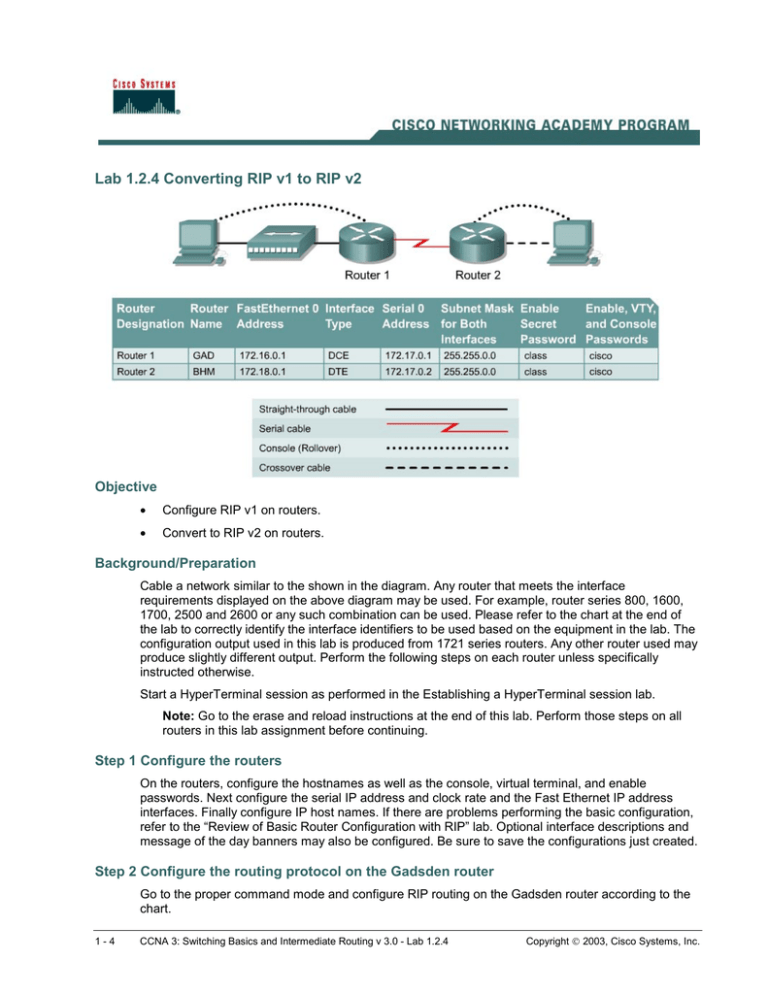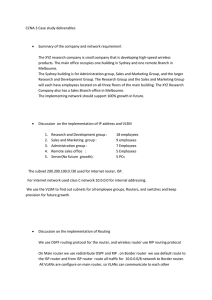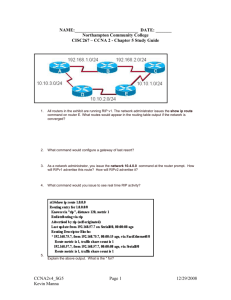Lab 1.2.4 Converting RIP v1 to RIP v2 Objective Background/Preparation
advertisement

Lab 1.2.4 Converting RIP v1 to RIP v2 Objective • Configure RIP v1 on routers. • Convert to RIP v2 on routers. Background/Preparation Cable a network similar to the shown in the diagram. Any router that meets the interface requirements displayed on the above diagram may be used. For example, router series 800, 1600, 1700, 2500 and 2600 or any such combination can be used. Please refer to the chart at the end of the lab to correctly identify the interface identifiers to be used based on the equipment in the lab. The configuration output used in this lab is produced from 1721 series routers. Any other router used may produce slightly different output. Perform the following steps on each router unless specifically instructed otherwise. Start a HyperTerminal session as performed in the Establishing a HyperTerminal session lab. Note: Go to the erase and reload instructions at the end of this lab. Perform those steps on all routers in this lab assignment before continuing. Step 1 Configure the routers On the routers, configure the hostnames as well as the console, virtual terminal, and enable passwords. Next configure the serial IP address and clock rate and the Fast Ethernet IP address interfaces. Finally configure IP host names. If there are problems performing the basic configuration, refer to the “Review of Basic Router Configuration with RIP” lab. Optional interface descriptions and message of the day banners may also be configured. Be sure to save the configurations just created. Step 2 Configure the routing protocol on the Gadsden router Go to the proper command mode and configure RIP routing on the Gadsden router according to the chart. 1-4 CCNA 3: Switching Basics and Intermediate Routing v 3.0 - Lab 1.2.4 Copyright 2003, Cisco Systems, Inc. Step 3 Save the Gadsden router configuration Any time that changes are correctly made to the running configuration, they should be saved to the startup configuration. Otherwise, if the router is reloaded or power cycled, the changes that are not saved in the startup configuration will be lost. Step 4 Configure the routing protocol on the Birmingham router Go to the proper command mode and configure RIP routing on the Birmingham router according to the chart. Step 5 Save the Birmingham router configuration Step 6 Configure the hosts with the proper IP address, subnet mask, and default gateway Step 7 Verify that the internetwork is functioning by pinging the FastEthernet interface of the other router a. From the host attached to GAD, ping the other host attached to the BHM router. Was the ping successful? ___________ b. From the host attached to BHM, ping the other host attached to the GAD router. Was the ping successful? ___________ c. If the answer is no for either question, troubleshoot the router configurations to find the error. Then do the pings again until the answer to both questions is yes. Step 8 Enable RIP version 2 routing a. Enable version 2 of the RIP routing protocol on both of the routers Gadsden and Birmingham. GAD(config)#router rip GAD(config-router)#version 2 GAD(config-router)#exit GAD(config)#exit BHM(config)#router rip BHM(config-router)#version 2 BHM(config-router)#exit BHM(config)#exit Step 9 Ping all of the interfaces on the network from each host a. Were all of the interfaces still able to be pinged? ___________________________________ b. If not, troubleshoot the network and ping again. Once the previous steps are completed, logoff by typing exit, and turn the router off. Then remove and store the cables and adapter. 2-4 CCNA 3: Switching Basics and Intermediate Routing v 3.0 - Lab 1.2.4 Copyright 2003, Cisco Systems, Inc. Erasing and reloading the router Enter into the privileged EXEC mode by typing enable. If prompted for a password, enter class. If that does not work, ask the instructor for assistance. Router>enable At the privileged EXEC mode, enter the command erase startup-config. Router#erase startup-config The responding line prompt will be: Erasing the nvram filesystem will remove all files! Continue? [confirm] Press Enter to confirm. The response should be: Erase of nvram: complete Now at the privileged EXEC mode, enter the command reload. Router(config)#reload The responding line prompt will be: System configuration has been modified. Save? [yes/no]: Type n and then press Enter. The responding line prompt will be: Proceed with reload? [confirm] Press Enter to confirm. In the first line of the response will be: Reload requested by console. After the router has reloaded the line prompt will be: Would you like to enter the initial configuration dialog? [yes/no]: Type n and then press Enter. The responding line prompt will be: Press RETURN to get started! Press Enter. Now the router is ready for the assigned lab to be performed. 3-4 CCNA 3: Switching Basics and Intermediate Routing v 3.0 - Lab 1.2.4 Copyright 2003, Cisco Systems, Inc. Router Interface Summary Ethernet Ethernet Serial Serial Interface #1 Interface #2 Interface #1 Interface #2 800 (806) Ethernet 0 (E0) Ethernet 1 (E1) 1600 Ethernet 0 (E0) Ethernet 1 (E1) Serial 0 (S0) Serial 1 (S1) 1700 FastEthernet 0 (FA0) FastEthernet 1 (FA1) Serial 0 (S0) Serial 1 (S1) 2500 Ethernet 0 (E0) Ethernet 1 (E1) Serial 0 (S0) Serial 1 (S1) FastEthernet 0/0 2600 FastEthernet 0/1 (FA0/1) Serial 0/0 (S0/0) Serial 0/1 (S0/1) (FA0/0) In order to find out exactly how the router is configured, look at the interfaces. This will identify what type and how many interfaces the router has. There is no way to effectively list all of the combinations of configurations for each router class. What is provided are the identifiers for the possible combinations of interfaces in the device. This interface chart does not include any other type of interface even though a specific router may contain one. An example of this might be an ISDN BRI interface. The string in parenthesis is the legal abbreviation that can be used in IOS command to represent the interface. Router Model 4-4 CCNA 3: Switching Basics and Intermediate Routing v 3.0 - Lab 1.2.4 Copyright 2003, Cisco Systems, Inc.






